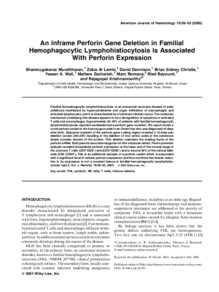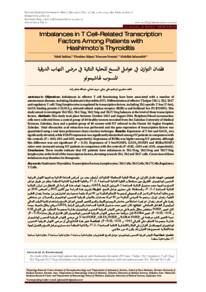Document
An inframe perforin gene deletion in familial hemophagocytic lymphohistiocytosis is associated with perforin expression.
Identifier
DOI: 10.1002/ajh.20256
Source
American Journal of Hematology. v. 78, 1, p. 59-63
Contributors
Al-Lamkiyah, Zakia., Author
Dennison, David., Author
Christie, Brian Sidney., Author
Wali, Yasser A., Author
Zachariah, Mathew., Author
Romana, Marc., Author
Bayoumi, Riad., Author
Krishnamoorthy, Rajagopal., Author
Country
United States.
City
Hoboken
Publisher
Wiley-Liss, Inc.
Gregorian
2005-01-01
Language
English
Subject
English abstract
Familial hemophagocytic lymphohistiocytosis is an autosomal recessive disease of early childhood manifested by hypercytokinemia and organ infiltration of macrophages and activated lymphocytes, and it is characterized by a fulminant clinical course. The molecular mechanism underlying this disease appears to be a deregulation of apoptosis of activated T cells and macrophages. Approximately 20-40% of patients with familial hemophagocytic lymphohistiocytosis reported worldwide had a perform gene mutation. We report herein a novel perforin variant in the homozygous state in an Omani boy who was diagnosed 44 days after birth. Sequence analysis of the perform gene coding region revealed a 12-base pair deletion (codon 284-287) resulting in the deletion of four amino acids in the membrane attack complex domain of the protein. This deletion maintains the reading frame of the perforin mRNA. Both parents were heterozygotes for this molecular defect. Flow-cytometric analysis revealed intracellular perform expression at the lower end of the normal range in the cytotoxic T cells (CD3+/CD8+) and (CD3 +/CD56+) and in around 50% of the natural killer cells (CD3-/CD56+). This is an additional example of a perforin variant which is associated with a significant level of cellular perforin expression and thus confirms that drastic reduction in its expression is not a constant feature in familial hemophagocytic lymphohistiocytosis type 2.
ISSN
0361-8609
Resource URL
Category
Journal articles


